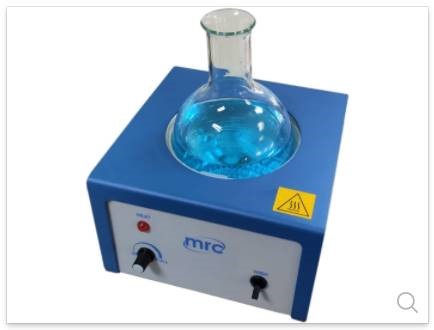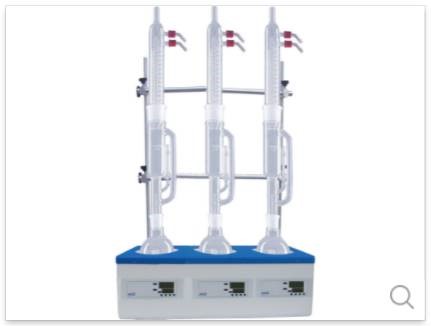MRC laboratory heating mantles with analog or digital temperature control for various volumes with optional magnetic stirrers.Heating mantles allow direct contact with glassware because the heating element is usually insulated from the container.The temperature is usually controlled by a thermostat, which makes keeping the temperature simpler.Heating mantles are used to extract and distill materials, such as extracting flavors and aromas of foods, useful today in molecular cooking and in the preparation of alcoholic beverages.
What are Heating mantles
Heating mantles are an essential tool in the laboratory for heating or tempering organic liquids placed in reaction vessels. They are designed to provide a safe and efficient means of heating liquids, and they can be used for a wide range of applications, including boiling, evaporation, distillation, and extraction. Whether you are a researcher, a chemist, or a student, a heating mantle is a valuable tool for your work. With its uniform heat source and temperature control capabilities, a heating mantle provides an excellent solution for heating liquids in the laboratory.
Uses of laboratory Heating Mantles
Heating mantles are used for extraction (Soxhlet extractor) in the food industry For the analysis of fats in raw materials of food and finished foods, pet foods,
Kernels, seeds and grains, animal and fish foods, and dairy products.
How to choose laboratory Heating Mantles
-The volume of the glass vessel that the device heats must be adjusted to obtain close contact.
Between the vessel and the heating element, the volumes range from 50 ml to 10-liter heating coats.
- The temperature range is up to 450 degrees Celsius and is very popular in the processes of extraction, evaporation, and refining, the field of food, botany, cannabis, and more.
-The temperature control can be analog or digital
-Be careful not to operate the device without glassware with liquid in it, this can cause the heating element to burn.
-There are universal heating jackets that are suitable for dishes from a volume of 250 ml to 2000 ml that are protected against breakage and leakage of liquid into them
The size of the heater
Spherical Flask must be inside the heating mantle and filled with liquid, otherwise it may burn., Do not put a small Spherical in a large-diameter heating mantle.
They can be ordered from a volume of 50 ml up to 20 liters.
- Leakage or breakage of liquid from Spherical Flask will cause destruction of the heating mantle.

One position or multiple positions
Arrive in single or multi-position, usually 3 positions or 6 positions

Heating Mantle with a magnetic stirrer
Some heating mantle has a magnetic stirrer to stir the solution and improve its uniformity.
Analog or digital temperature control
- Can come with analog temperature control or digital temperature control.
Function of Heating Mantles
Heating mantles are designed to evenly heat liquids placed in reaction vessels. They are typically made of a heat-resistant material, such as fiberglass, that is wrapped around the reaction vessel. The heating mantle is then connected to an electrical heating element, which is controlled by a temperature controller. As the electrical current is passed through the heating element, it generates heat, which is transferred to the heating mantle and the reaction vessel, thereby heating the liquid.
Applications of Heating Mantles
Boiling: Heating mantles are used to boil liquids in the laboratory, either for the purpose of distillation or to reduce the volume of a liquid. By providing a uniform heat source, heating mantles ensure that the liquid is heated evenly and consistently, which reduces the risk of boiling over or boiling too fast.
Evaporation: Used to evaporate liquids in the laboratory, either for the purpose of concentrating a solution or to recover a volatile component. By providing a controlled heat source, heating mantles ensure that the evaporation process is consistent and efficient.
Distillation: Used in distillation, a process in which a mixture of liquids is heated and then condensed to separate the components. By providing a uniform heat source, heating mantles ensure that the mixture is heated evenly, which reduces the risk of contamination and improves the efficiency of the distillation process.
Extraction: Used in extraction, a process in which a solid or liquid is mixed with a solvent to dissolve a desired component. By providing a controlled heat source, heating mantles ensure that the extraction process is efficient and consistent, which reduces the risk of contamination and improves the yield of the extracted component.
How to use laboratory Heating Mantles?-General instructions
Using a laboratory heating mantle safely and effectively requires following specific steps. Here's a general guide to help you:
1. Safety Precautions
Wear appropriate PPE: Always wear gloves, goggles, and a lab coat when working with heating mantles.
Work in a well-ventilated area: Ensure good ventilation to prevent any buildup of harmful fumes.
Check the heating mantle: Inspect the mantle for any damage, exposed wires, or fraying before use. A damaged mantle should not be used.
2. Set Up
Place the heating mantle on a stable surface: Ensure it’s on a flat, heat-resistant surface.
Insert the flask: Place your round-bottom flask inside the heating mantle. The flask should fit snugly in the mantle to ensure even heating.
Clamp the flask: Secure the flask with a clamp to prevent it from moving or tipping over during heating.
Use a temperature controller: Most heating mantles do not have built-in temperature controls, so connect the mantle to an external temperature controller to adjust the heat.
3. Operation
Set the desired temperature: Use the temperature controller to gradually increase the heat. Avoid turning the mantle to the maximum temperature immediately, as this can cause uneven heating and flask breakage.
Monitor the reaction: Keep an eye on your experiment, especially in the initial heating stages. Some mantles have no built-in temperature sensors, so it’s essential to use an external thermometer or thermocouple.
Stirring: If required, use a magnetic stir bar inside the flask and place the heating mantle on a stirrer platform.
4. Shutting Down
Turn off the power: Once the desired heating period is complete, turn off the heating mantle by disconnecting the power source.
Allow to cool: Let the heating mantle cool down completely before removing the flask.
Clean up: Clean the flask and the heating mantle (if necessary) before storing it.